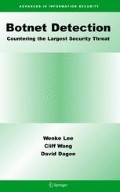Access this chapter
Tax calculation will be finalised at checkout
Purchases are for personal use only
Preview
Unable to display preview. Download preview PDF.
References
Taormina, Sicily, Italy, October 2004.
Bobax trojan analysis. http://www.lurhq.com/bobax.html, March 2005.
Symantec Security Alert–W32.Bobax.D worm. http://www.sarc.com/ avcenter/venc/data/w32.bobax.d.html.
David Brumley. Tracking hackers on IRC. http://www.doomdead.com/texts/ ircmirc/TrackingHackersonIRC.htm, 2003.
CNN Technology News. Expert: Botnets No. 1 emerging Internet threat. http://www. cnn.com/2006/TECH/internet/01/31/furst/, January 2006.
Evan Cooke, Farnam Jahanian, and Danny McPherson. The Zombie Roundup: Understanding, Detecting and Disrupting Botnets. In Usenix Workshop on Steps to Reducing Unwanted Traffic on the Internet (SRUTI), June 2005.
David Dagon, Cliff Zou, and Wenke Lee. Modeling botnet propagation using time zones. In Proceedings of the 13th Annual Network and Distributed System Security Symposium (NDSS ’06), 2006.
S. Dietrich, N. Long, and D. Dittrich. Analyzing distributed denial of service attack tools: The shaft case. In Proceedings of the LISA 2000 System Administration Conference, December 2000.
Felix C. Freiling, Thorsten Holz, and Georg Wicherski. Botnet tracking: Exploring a root-cause methodology to prevent distributed denial-of-service attacks. Technical Report ISSN-0935-3232, RWTH Aachen, April 2005.
Luis H. Gomes, Cristiano Cazita, Jussara Almeida, Virgilio Almeida, and Wagner Meira. Characterizing a Spam Traffic. In Proc. ACM SIGCOMM Internet Measurement Conference[1].
Christopher Hanna. Using snort to detect rogue IRC bot programs. Technical report, October 2004.
12. Jaeyeon Jung and Emil Sit. An Empirical Study of Spam Traffic and the Use of DNS Black Lists. In Proc. ACM SIGCOMM Internet Measurement Conference[1], pages 370–375.
Srikanth Kandula, Dina Katabi, Matthias Jacob, and Arthur Berger. Botz-4-Sale: Surviving Organized DDoS Attacks That Mimic Flash Crowds. In Proc. 2nd Symposium on Networked Systems Design and Implementation (NSDI), Boston, MA, May 2005.
Sven Krasser, Gregory Conti, Julian Grizzard, Jeff Gribschaw, and Henry Owen. Real-time and forensic network data analysis using animated and coordinated visualization. In Proceedings of the 6th IEEE Information Assurance Workshop, 2005.
Brian Krebs. Bringing botnets out of the shadows. http://www.washingtonpost.com/wp-dyn/content/article/2006/03/21/AR20060%32100279. html, 2006.
D. Moore, Geoffrey M. Voelker, and Stefan Savage. Inferring internet denial-of-service activity. In Proceedings of the 2001 USENIX Security Symposium, 2001.
Stephan Racine. Analysis of internet relay chat usage by ddos zombies. ftp://www. tik.ee.ethz.ch/pub/students/2003-2004-Wi/MA-2004-01.pdf, 2004.
Anirudh Ramachandran and Nick Feamster. Understanding the Network-Level Behavior of Spammers. In Proc. ACM SIGCOMM, Pisa, Italy, September 2006.
Puri Ramneek. Bots & Botnets: An Overview. http://www.giac.com/practical/GSEC/Ramneek_Puri_GSEC.pdf, 2003.
S.E. Schechter and M.D. Smith. Access for sale. In 2003 ACM Workshop on Rapid Malcode (WORM’03). ACM SIGSAC, October 2003.
SpamAssassin, 2005. http://www.spamassassin.org/.
SwatIt. Bots, drones, zombies, worms and other things that go bump in the night. http: //swatit.org/bots/, 2004.
Virus Bulletin 2005 Paper on ’Bots and Botnets’. http://arachnid.homeip.net/papers/VB2005-Bots_and_Botnets-1.0.2.pdf.
Y. Zhang and V. Paxson. Detecting stepping stones. In Proceedings of the 9th USENIX Security Symposium, August 2000.
Author information
Authors and Affiliations
Editor information
Editors and Affiliations
Rights and permissions
Copyright information
© 2008 Springer Science+Business Media, LLC
About this chapter
Cite this chapter
Ramachandran, A., Feamster, N., Dagon, D. (2008). Detecting Botnet Membership with DNSBL Counterintelligence. In: Lee, W., Wang, C., Dagon, D. (eds) Botnet Detection. Advances in Information Security, vol 36. Springer, Boston, MA. https://doi.org/10.1007/978-0-387-68768-1_7
Download citation
DOI: https://doi.org/10.1007/978-0-387-68768-1_7
Publisher Name: Springer, Boston, MA
Print ISBN: 978-0-387-68766-7
Online ISBN: 978-0-387-68768-1
eBook Packages: Computer ScienceComputer Science (R0)

